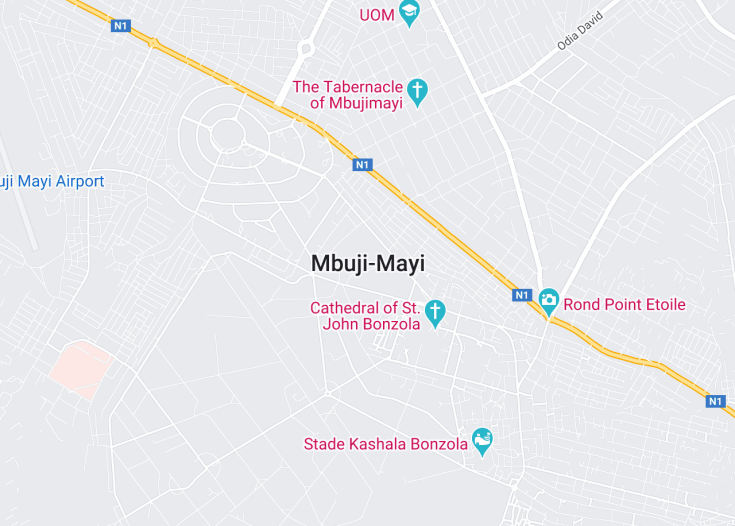Mbuji-Mayi, the capital of the Kasai-Oriental Province in the Democratic Republic of the Congo, presents an intriguing blend of urban energy and rich cultural heritage. Renowned for its vast diamond mines, the city offers visitors a unique glimpse into one of the world’s most vibrant gem-trading centers. Although not traditionally designed for tourism, its bustling markets, local cuisine, and warm-hearted residents provide a unique cultural experience. The city’s remote location and authentic atmosphere make it a perfect destination for adventurous travelers seeking to explore the less trodden paths of Africa.
When visiting Mbuji-Mayi, be sure to hire a local guide. Their knowledge not only enriches your experience but also ensures safer and smoother travel within the city.
Plan your visit during the dry season, from May to September, to avoid the heavy rains that could hinder travel and outdoor activities in the region.
Top things to do & see in Mbuji-Mayi
Select the following sights and activities to discover best tickets and tours available in Mbuji-Mayi.
Mbuji-Mayi: Gem of the Kasai
| Country | Democratic Republic of the Congo – Kinshasa |
| Time in Mbuji-Mayi | GMT+2 |
| Language spoken | Tshiluba |
| Population | 1,200,000 (est. 2023, National Census Bureau) |
| Currency | Congolese franc (CDF ₣) |
| Airports |
|
Mbuji-Mayi, often referred to as the heart of the Kasai region of the Democratic Republic of the Congo, is a city steeped in cultural history and economic importance. As the capital of Kasai-Oriental Province, it sits prominently as a central hub for the vast mineral wealth of the region, particularly known for its prolific diamond mines which are among the largest in the world.
The city’s origin dates back to colonial times, but it rapidly developed with the diamond rush in the mid-20th century. Today, Mbuji-Mayi serves not just as an economic powerhouse but as a vibrant cultural center as well. The local traditions and customs are deeply integrated with the modern lifestyle, creating a unique blend that embodies the spirit of both past and present Congo.
Despite its significant economic contributions, especially in the diamond sector, Mbuji-Mayi faces numerous challenges including infrastructural deficits and the need for sustainable development practices to ensure the well-being of its growing population. The city’s strategic importance continues to shape its developmental policies, aiming to harness its resources effectively while ensuring environmental stewardship and social equity.
Education and healthcare are also central to the city’s developmental agenda, with numerous initiatives aimed at improving the quality of life for its residents. The presence of various educational institutions, including higher education facilities, are pivotal in fostering a knowledgeable and skilled workforce capable of advancing Mbuji-Mayi’s economic and social sectors.
Where is Mbuji-Mayi?
Mbuji-Mayi is situated in the southern-central part of the Democratic Republic of the Congo, lying between the rivers Sankuru and Kasai.
Distances:
| Route | Distance by car | Time by car |
|---|---|---|
| Kinshasa to Mbuji-Mayi | 880 km | Approx. 18 hours |
| Lubumbashi to Mbuji-Mayi | 1000 km | Approx. 20-22 hours |
What is Mbuji-Mayi famous for?
Mbuji-Mayi is renowned as a major world center for diamond mining, significantly contributing to the global diamond market. Its mines extract some of the highest-quality diamonds, shaping both local and international economies.
History
Pre-20th Century
Mbuji-Mayi, originally inhabited by the local Luba people, has a rich cultural and historical lineage rooted in the vast tapestry of Central Africa’s historic kingdoms. Before European colonization, it was part of a larger region dominated by the Luba and Lunda kingdoms, which engaged in extensive trade networks and wielded considerable influence in Central Africa. The area was known for its skilled artisans and bustling markets, which traded ivory, copper, and slaves.
20th Century – Post-Colonial Era
The discovery of diamonds in the 20th century dramatically transformed Mbuji-Mayi, turning it from a relatively obscure village into one of the world’s major diamond-producing cities. During the colonial period, the region came under Belgian control, which led to significant infrastructural developments but also harsh exploitation. Post-independence in 1960, Mbuji-Mayi gained prominence as the economic heart of the Kasai region, although it was also a focal point of political unrest and conflict during the Congolese civil wars.
21st Century – Present
Today, Mbuji-Mayi is grappling with challenges typical of many post-colonial African cities, including governance issues, infrastructural decay, and socio-economic disparities. Despite these challenges, it remains an essential part of the Democratic Republic of the Congo’s cultural and economic landscape, with ongoing endeavors to capitalize on its rich mineral resources while addressing the needs and wellbeing of its population.
Visit Mbuji-Mayi
What to see and do in Mbuji-Mayi, Democratic Republic of the Congo – Kinshasa
Explore the vibrant city of Mbuji-Mayi, renowned for its rich cultural heritage and natural resources. Key attractions include:
- Tshibua Market: Immerse yourself in local culture at this bustling market, where you can find everything from handcrafted artifacts to traditional foods.
- Mbuji-Mayi Cathedral: Visit this architectural marvel, which stands as a symbol of resilience and faith in the heart of the city.
- Diamond Mines: Learn about the city’s diamond mining industry by taking a guided tour of one of the local mines.
- Luba Art Exhibitions: Discover the artistic heritage of the Luba people through various art exhibitions and cultural shows held throughout the year.
Annual Cultural Festivals
Mbuji-Mayi hosts several cultural festivals annually, celebrating its rich traditions and promoting local arts. Notable events include the Luba Festival, typically held in the dry season (May to September), where traditional dances, music, and crafts are displayed, drawing visitors from across the region and beyond.
Best time to visit Mbuji-Mayi
The best time to visit Mbuji-Mayi is during the dry season, from May to September, when the weather is most favorable for exploring the city and partaking in outdoor activities.
is Mbuji-Mayi worth visiting?
While Mbuji-Mayi might not feature prominently on typical tourist itineraries, it offers a unique glimpse into the heart of the Congolese diamond industry and the rich cultural fabric of the Luba people. However, potential visitors should be aware of the logistical challenges, including limited tourist infrastructure and ongoing economic issues. Despite these hurdles, for those interested in the raw and untamed facets of Central Africa, Mbuji-Mayi offers a compelling, albeit rugged, travel experience.










